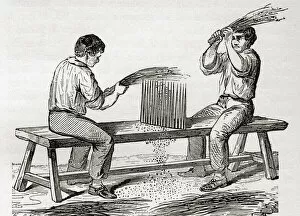Textile Collection (page 100)
"From ancient battles to spiritual realms, textile art weaves stories of culture and history
All Professionally Made to Order for Quick Shipping
"From ancient battles to spiritual realms, textile art weaves stories of culture and history. The Bayeux Tapestry, created between 1066-1077, vividly depicts scenes from the Battle of Hastings, transporting us back in time. In Bardo Mandala, a Thangka painting showcasing the period between death and reincarnation, intricate textiles capture the ethereal journey of the soul. Even advertisements have utilized textiles to captivate audiences throughout history. A Singer sewing machine ad from the 1890s showcases how these machines revolutionized textile production and empowered individuals with their own creative abilities. Across continents, traditional textile techniques reflect unique cultural identities. Kuna Indian traditional molas from Cristobal in Central America's Panama showcase vibrant patterns that tell stories passed down through generations. Textiles also find their way into artistic interpretations of legends and visions. "The Attainment; The Vision of the Holy Grail" brings Sir Galahad, Sir Bors, and Sir Percival's quest to life through intricately woven fabrics. Traveling further afield reveals stunning street scenes captured on fabric canvases. Charles Robertson's "A Street Scene in Cairo" transports us to bustling markets filled with colorful textiles that epitomize Egyptian culture. Maps too can be transformed into works of art using textiles as seen in a Buenos Aires map where threads create an intricate representation of city streets. In Costa Rican art, vibrant colors blend seamlessly with indigenous motifs representing Central American heritage while flags of the German Empire showcase national pride through carefully crafted fabrics. Throughout history, fabric design has been celebrated for its beauty and innovation. Art Gout Beaute's 1924 collection exemplifies this creativity by combining bold patterns with luxurious materials. Finally, Ghana's Ashanti Region offers a glimpse into West African textile traditions where skillful craftsmanship meets storytelling through cloth weaving techniques. "














